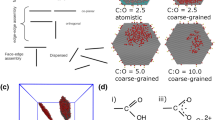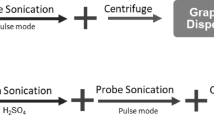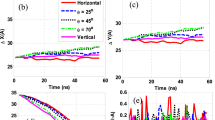Abstract
Graphene sheets offer extraordinary electronic, thermal and mechanical properties and are expected to find a variety of applications. A prerequisite for exploiting most proposed applications for graphene is the availability of processable graphene sheets in large quantities. The direct dispersion of hydrophobic graphite or graphene sheets in water without the assistance of dispersing agents has generally been considered to be an insurmountable challenge. Here we report that chemically converted graphene sheets obtained from graphite can readily form stable aqueous colloids through electrostatic stabilization. This discovery has enabled us to develop a facile approach to large-scale production of aqueous graphene dispersions without the need for polymeric or surfactant stabilizers. Our findings make it possible to process graphene materials using low-cost solution processing techniques, opening up enormous opportunities to use this unique carbon nanostructure for many technological applications.
This is a preview of subscription content, access via your institution
Access options
Subscribe to this journal
Receive 12 print issues and online access
$259.00 per year
only $21.58 per issue
Buy this article
- Purchase on Springer Link
- Instant access to full article PDF
Prices may be subject to local taxes which are calculated during checkout





Similar content being viewed by others
References
Geim, A. K. & Novoselov, K. S. The rise of graphene. Nature Mater. 6, 183–191 (2007).
Stankovich, S. et al. Synthesis of graphene-based nanosheets via chemical reduction of exfoliated graphite oxide. Carbon 45, 1558–1565 (2007).
McAllister, M. J. et al. Single sheet functionalized graphene by oxidation and thermal expansion of graphite. Chem. Mater. 19, 4396–4404 (2007).
Stankovich, S. et al. Stable aqueous dispersions of graphitic nanoplatelets via the reduction of exfoliated graphite oxide in the presence of poly(sodium 4-styrenesulfonate). J. Mater. Chem. 16, 155–158 (2006).
Niyogi, S. et al. Solution properties of graphite and graphene. J. Am. Chem. Soc. 128, 7720–7721 (2006).
Stankovich, S. et al. Graphene-based composite materials. Nature 442, 282–286 (2006).
Novoselov, K. S. et al. Electric field effect in atomically thin carbon films. Science 306, 666–669 (2004).
Kotov, N. A., Dekany, I. & Fendler, J. H. Ultrathin graphite oxide–polyelectrolyte composites prepared by self-assembly: transition between conductive and non-conductive states. Adv. Mater. 8, 637–641 (1996).
Cassagneau, T., Guerin, F. & Fendler, J. H. Preparation and characterization of ultrathin films layer-by-layer self-assembled from graphite oxide nanoplatelets and polymers. Langmuir 16, 7318–7324 (2000).
Kovtyukhova, N. I. et al. Layer-by-layer assembly of ultrathin composite films from micron-sized graphite oxide sheets and polycations. Chem. Mater. 11, 771–778 (1999).
Hirata, M., Gotou, T. & Ohba, M. Thin-film particles of graphite oxide 2: Preliminary studies for internal micro fabrication of single particle and carbonaceous electronic circuits. Carbon 43, 503–510 (2005).
Szabo, T., Szeri, A. & Dekany, I. Composite graphitic nanolayers prepared by self-assembly between finely dispersed graphite oxide and a cationic polymer. Carbon 43, 87–94 (2005).
Lerf, A., He, H. Y., Forster, M. & Klinowski, J. Structure of graphite oxide revisited. J. Phys. Chem. B 102, 4477–4482 (1998).
Szabo, T. et al. Evolution of surface functional groups in a series of progressively oxidized graphite oxides. Chem. Mater. 18, 2740–2749 (2006).
Everett, D. H. Basic Principles of Colloid Science (The Royal Society of Chemistry, London, 1988).
Li, D. & Kaner, R. B. Processable stabilizer-free polyaniline nanofiber aqueous colloids. Chem. Commun. 3286–3288 (2005).
Baughman, R. H., Zakhidov, A. A. & de Heer, W. A. Carbon nanotubes—the route toward applications. Science 297, 787–792 (2002).
Niyogi, S. et al. Chemistry of single-walled carbon nanotubes. Acc. Chem. Res. 35, 1105–1113 (2002).
Bahr, J. L. & Tour, J. M. Covalent chemistry of single-wall carbon nanotubes. J. Mater. Chem. 12, 1952–1958 (2002).
Sun, Y. P., Fu, K. F., Lin, Y. & Huang, W. J. Functionalized carbon nanotubes: properties and applications. Acc. Chem. Res. 35, 1096–1104 (2002).
Gilje, S., Han, S., Wang, M., Wang, W. & Kaner, R. B. A chemical route to graphene for device applications. Nano Lett. 7, 3394–3398 (2007).
Gómez-Navarro, C. et al. Electronic transport properties of individual chemically reduced graphene oxide sheets. Nano Lett. 7, 3499–3503 (2007).
Skakalova, V., Kaiser, A. B., Dettlaff-Weglikowska, U., Hrncarikova, K. & Roth, S. Effect of chemical treatment on electrical conductivity, infrared absorption, and Raman spectra of single-walled carbon nanotubes. J. Phys. Chem. B 109, 7174–7181 (2005).
Dikin, D. A. et al. Preparation and characterization of graphene oxide paper. Nature 448, 457–460 (2007).
Kirchmeyer, S. & Reuter, K. Scientific importance, properties and growing applications of poly(3,4-ethylenedioxythiophene). J. Mater. Chem. 15, 2077–2088 (2005).
Decher, G. Fuzzy nanoassemblies: toward layered polymeric multicomposites. Science 277, 1232–1237 (1997).
Hammond, P. T. Form and function in multilayer assembly: new applications at the nanoscale. Adv. Mater. 16, 1271–1293 (2004).
Tang, Z. Y., Wang, Y., Podsiadlo, P. & Kotov, N. A. Biomedical applications of layer-by-layer assembly: from biomimetics to tissue engineering. Adv. Mater. 18, 3203–3224 (2006).
Jan, E. & Kotov, N. A. Successful differentiation of mouse neural stem cells on layer-by-layer assembled single-walled carbon nanotubes composite. Nano Lett. 7, 1123–1128 (2007).
Hummers, W. S. & Offeman, R. E. Preparation of graphite oxide. J. Am. Chem. Soc. 80, 1339 (1958).
Acknowledgements
D.L. and G.G.W. acknowledge support from the Australian Research Council. R.B.K. thanks the Microelectronics Advanced Research Corporation for financial support.
Author information
Authors and Affiliations
Contributions
D.L. conceived and designed the experiments, R.B.K. and G.G.W. were involved in discussions on the design and interpretation of the experiments, and D.L., M.B.M. and S.G. performed the experiments. D.L., R.B.K. and G.G.W. co-wrote the paper. All the authors discussed the results and commented on the manuscript.
Corresponding authors
Supplementary information
Supplementary Information
Supplementary information and supplementary table S1 (PDF 171 kb)
Rights and permissions
About this article
Cite this article
Li, D., Müller, M., Gilje, S. et al. Processable aqueous dispersions of graphene nanosheets. Nature Nanotech 3, 101–105 (2008). https://doi.org/10.1038/nnano.2007.451
Received:
Accepted:
Published:
Issue Date:
DOI: https://doi.org/10.1038/nnano.2007.451
This article is cited by
-
Stepwise reduction of graphene oxide and studies on defect-controlled physical properties
Scientific Reports (2024)
-
Transient chemical and structural changes in graphene oxide during ripening
Nature Communications (2024)
-
Reduced graphene oxide/polyurethane composite sponge fabricated by dual-templates method for piezoresistive pressure sensor
Carbon Letters (2024)
-
Durable graphene-based alkyd nanocomposites for surface coating applications
Environmental Science and Pollution Research (2024)
-
Comparison of the effect of various carbon-based nanomaterials for the removal of Cu2+ ions from aqueous solutions
Chemical Papers (2024)



